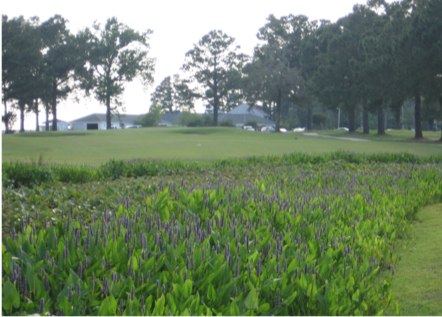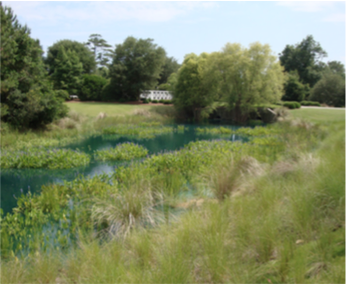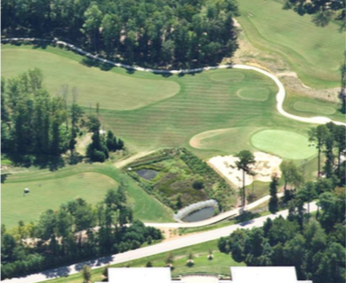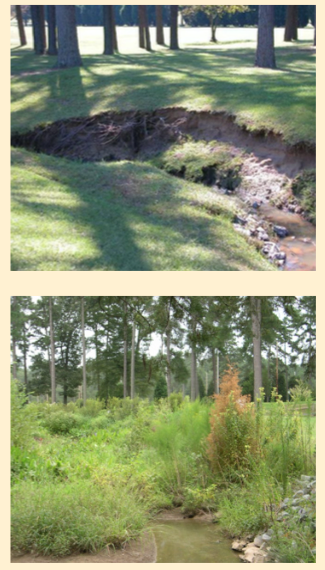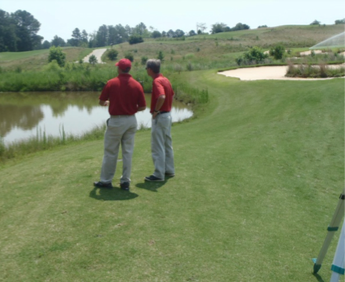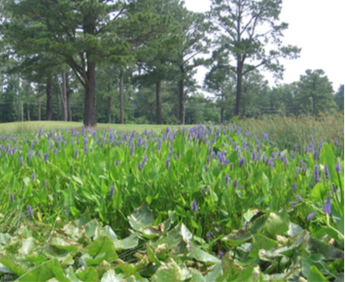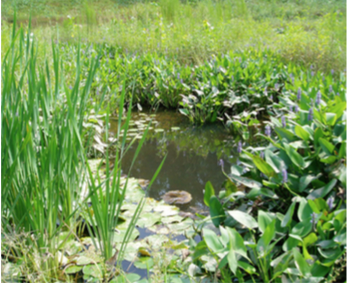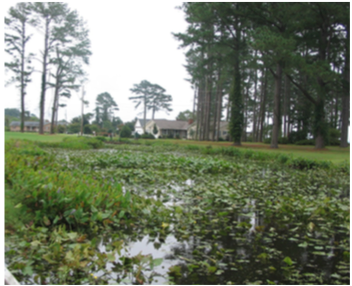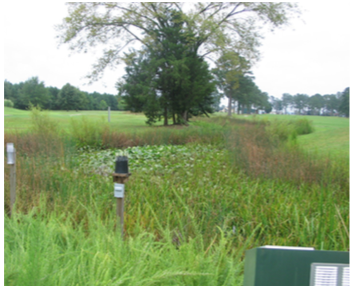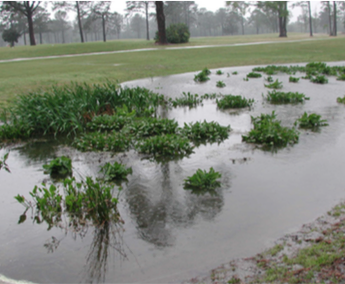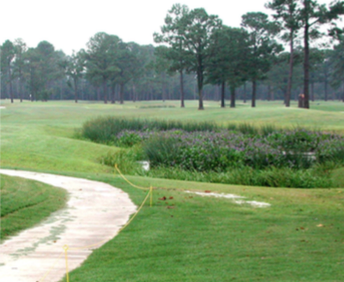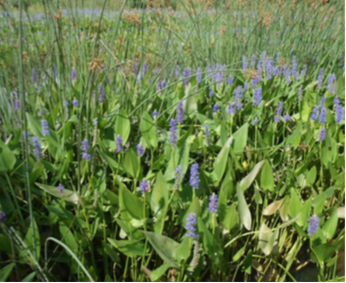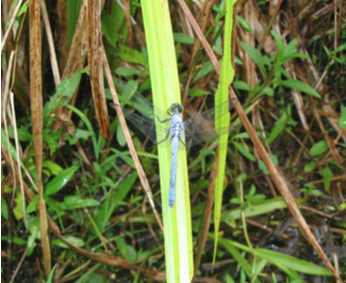Golf course designers and superintendents are increasingly taking steps to protect nearby environmental resources from potential negative impacts. New regulations and incentives also encourage designers and superintendents to pursue sound management and use greener technologies. One of the most frequently recommended practices for protecting the environment around a golf course is to incorporate constructed stormwater wetlands (CSWs) as a part of the water management plan for the course.
A CSW can be an attractive and practical way to meet requirements for water management design or retrofitting (Figure 1). CSWs not only remove nutrients; they also provide ecosystem services such as wildlife habitat and carbon sequestration. These services provide an additional opportunity for the course to expand its involvement into environmental protection programs that could generate additional recognition or revenue.
Introduction
The growing popularity of stormwater wetlands stems from their potential to improve water quality and reduce the quantity of runoff leaving a site. Wetlands are natural water filters. The biological, chemical, and physical conditions within wetlands create ideal conditions for removing many pollutants from water. Research at NC State University continues to show that wetlands are excellent at removing nutrients (Line et al., 2008; Lenhart and Hunt, 2011; Hathaway and Hunt, 2010). The benefits of wetlands also include the removal of harmful bacteria and regulation of organics (Hathaway et al., 2011; Moore et al., 2011). As a result of documented performance, the North Carolina Division of Environment and Natural Resources (NCDENR) currently offers 40% removal credit to CSWs for both nitrogen and phosphorus loads, which is among the highest credits awarded to any treatment practice (NCDENR, 2009). Wetlands store drainage water, dampen peak runoff rates, and increase on-site retention time. Wetlands can also reduce outflow volume through evaporation/plant transpiration and modest infiltration.
The United States Golf Association (USGA) has recognized stormwater wetlands as an acceptable means to reduce drainage outflow volumes and improve downstream water quality. For example, a research grant from the USGA Turfgrass and Environmental Research program supported a golf course project to manage runoff with stormwater wetlands at Purdue University. The project showed excellent results for water quality improvement (Kohler et al., 2004; Reicher et al., 2005).
In addition to their stormwater benefits, wetlands have other uses that can make them attractive golf course enhancements. Stormwater wetlands can function as an integral part of a drainage system, provide additional water storage for irrigation or other reuse needs, and offer an attractive alternative to traditional water hazards.
Recent engineering advancements have improved the wetland design process. Guidance on wetland construction and maintenance is readily available from other factsheets in this series: Stormwater Wetland Design Update: Zones, Vegetation, Soil, and Outlet Guidance (AG 588-12) and Stormwater Wetland Construction Guidance (AG 588-13).
This factsheet describes several example projects from North Carolina to illustrate how CSWs can be integrated into golf courses, and it provides recommendations for project success.
North Carolina's Golf Course Wetlands
In North Carolina, NC State Cooperative Extension and the Department of Biological and Agricultural Engineering have been involved with several CSWs on golf courses. One of the state’s first stormwater wetland demonstration projects was constructed in 2000 at Hillandale Golf Course in Durham. More recent golf course projects at Eagle Point Golf Club in Wilmington (Figure 2), Chowan Country Club in Edenton, and NC State’s Lonnie Poole Golf Course in Raleigh were intended to meet specific goals for water quality and to protect environmentally sensitive areas. Research data collection has been an integral part of all of these projects.
Chowan Country Club
A large retrofit was planned for the Chowan Country Club golf course to address drainage issues and improve course conditions. This course was situated immediately adjacent to the Albemarle Sound. The Department of Biological and Agricultural Engineering helped design a series of CSWs throughout the course to help manage drainage and improve water quality. A total of 15 acres of wetlands in eight areas were constructed as part of the project. More than half the holes on this course now include a water feature. Research on the project showed that the wetlands reduced both the quantity of stormwater runoff and the peak flow rates from the course. Nutrient loads exiting the course were also significantly reduced. Total nitrogen and phosphorus loads were decreased by 23% to 72%. Better performance was achieved when the ratio of wetland size to watershed area was higher (Pekarek, 2008).
Lonnie Poole Golf Course
The Lonnie Poole golf course is on NC State University’s Centennial Campus. The latest research-based concepts for environmental sustainability were used in the design of the facility, and these concepts are also applied to current management practices. The course was built under strict environmental regulations that protect streams, buffers, and wetlands. A number of water features are part of the course, including wet ponds, several natural wetland areas, and a stormwater wetland. The CSW collects and treats stormwater from the course and from a nearby public school before discharging to a well-buffered stream that flows through the course (Figure 3).
A study showed that this wetland reduced runoff volumes and improved water quality. Total nitrogen loads were reduced by 47%, and total phosphorus loads were reduced by 59%. The study further showed that a good portion of the pollutant removal was achieved through internal wetland processes rather than through water volume reduction. Other benefits described in the study included removal of solids and low nutrient concentrations in outflows (Line et al., 2008).
Wetland Locations
Stormwater wetlands have been used successfully in all regions of North Carolina. A wetland only needs periodic influxes of water to thrive. Water levels in most areas in a wetland should be less than one foot deep during normal conditions. Wetlands rarely require more than a small berm to retain water, and they can be managed with simple and inexpensive water control structures. A well-planned wetland is a living ecosystem, and once a diverse community of plants has established, a wetland is mostly self-sustaining, requiring minimal maintenance.
Any area that is experiencing periodic wetness or drainage problems on a golf course is a prime location for a wetland. Small ditches or other drainageways can be converted into wetland areas (Figure 4). Existing ponds or old ponds with failed dams are also good candidates for a wetland retrofit. A primary drainage outlet that leads from the golf course into a natural water body can also be an ideal location to position a wetland to provide some final runoff treatment. An example of this design is shown in Figure 2, where drainage water flows through the golf course and is intercepted by a CSW before it discharges into a salt marsh.
Eroding channel banks on small drainageways can also be targeted for wetland placement. This was the case at Hillandale Golf Course, where an eroding bank was both an eyesore and a safety hazard (Figure 5). In 2000 a wetland was installed adjacent to the first tee; now the wetland also serves as a water quality amenity and a visual screen that partially hides a parking lot.
Wetland Planning
Wetlands provide a designated area for water storage, which can efficiently keep water off of playing areas. When combined with a course drainage system, wetlands can decrease the impact of rainfall by providing multiple drainage outlets. In addition, spoil from excavation can sometimes be used to build up other low areas of the course. Improved drainage response will decrease the amount of time that players and traffic must be kept off the course, decreasing the potential for course damage.
Golf course wetland planning should involve significant input from the course designer and superintendent (Figure 6). They will be able to help identify wet areas, drainage systems, and course drainage retrofits or improvements that could bene t from wetlands. To get the most benefit out of these features, it is important to evaluate how wetland areas might affect play. Wetlands that can act as lateral or water hazards while providing an aesthetic amenity around the course can be highly desirable. Particularly at private clubs, additional input from the membership will be crucial to get support. A field visit to discuss potential wetland sites with respect to playability (i.e., landing areas) should be an integral part of the planning process.
There are many different types of wetlands that can be used in a golf course setting. Wetlands can be very small or many acres in size. Wetlands can be designed to work in series to combine variety and water quality benefits. The type of wetland constructed will depend on site location, watershed size, and the desired aesthetic result. Wetlands can be built with or without significant water storage, with varying areas of deep and shallow pools, and with differing plant communities (Figure 7 and Figure 8).
Deeper wetlands planted primarily with floating aquatics have a more pondlike appearance and a low profile, allowing golfers to see their target easily (Figure 9).
More natural-looking wetlands may involve a less sculpted look and may also include some trees (Figure 10). Such wetlands are excellent for border areas or zones where play is restricted. These areas may also provide the best wildlife habitat potential.
A design with a mixture of emergents will produce a wetland that has dense vegetation but that will still be low enough not to impede shot-making (Figure 11). This type of wetland will typically have a thick border of vegetation that will help restrict player access and provide dense cover for habitat.
Wetland fringes can be established by constructing a shallow water ledge or shelf around the perimeter of ponds (Figure 12). The shelf stabilizes the banks, which are often unvegetated because of over-mowing and fluctuating water levels in the pond. This provides excellent habitat for ducks and other waterfowl that like cover, but not for geese because they prefer open water with closely mowed, visible banks so they can see predators approaching.
Hydrologic Considerations
A stormwater wetland depends on the proper hydrologic conditions to function and remain sustainable. Potential sites should be investigated for a variety of hydrologic interactions. A thorough analysis is necessary to predict contributing watershed dynamics and determine local water table interaction, storage needs, and flooding risk (Figure 13).
When possible, soil sampling and groundwater level monitoring near targeted areas of the golf course should be completed before designing the wetlands. This will help designers understand the site’s groundwater hydrology, a critical component of project success. Information on seasonal water tables can provide important data for targeting wetland surface elevations. Shallow water table systems, such as those found in coastal areas, will typically have confining soil layers restricting vertical seepage. The depth of a coastal stormwater wetland must be carefully determined to manage water table interaction and to avoid breaching restrictive layers needed for surface water storage.
Other wetlands may be hydrologically isolated due to deeper water tables at the wetland site. These wetlands must be designed with clay or synthetic liners or specially created soil conditions to maintain desired water-level conditions. Additional analysis should be performed to ensure that the watershed is large enough to contribute a sufficient supply of runoff to the wetland.
An engineering analysis using spreadsheet routing routines or other computer models can facilitate these determinations. ere are a number of routing models that can simulate water levels and incorporate the effects of multiple wetlands or complex in-line structures.
Design Recommendations for Gold Course Wetlands
General design criteria applicable to all stormwater wetlands include vegetation selection, water depths, storage depths, and drawdown periods. Detailed recommendations on the design process are provided in various design manuals (see Resources section) and in the companion factsheets in this series.
An experienced local stormwater professional can identify any local design issues. Such issues may necessitate adjustments to traditional designs to make wetlands more manageable and attractive for golf course use.
Grading
Side slopes should be no steeper than 3:1 (horizontal:vertical) to facilitate maintenance and promote safety. Special attention should be paid to slope preparation, establishing vegetation, and setting mowing boundaries.
Topsoil
Topsoil should be incorporated into the wetland surface and bank slopes whenever possible. Good soil substrate will promote rapid plant establishment.
Planting
In highly visible locations, designate plant spacing of 2-foot centers or less. Dense coverage may be attainable at this spacing within a growing season.
The best coverage will result from planting emergent wetland vegetation in the spring. Summer or fall plantings may be successful, but initial results may be diminished due to heat and drought stress, as well as a shorter initial growing season.
A simple array of flowering herbaceous emergents will provide excellent aesthetic quality for the middle sections of the wetland. An outer layer of Juncus spp. (rush) or Scirpus spp. (bulrush, woolgrass) will provide a thick wetland border (Figure 14 and Figure 15).
Structures
Water control structures should be designed to allow for adjustable wetland water levels. For example, shallow water levels are needed initially for plant establishment and later for maintenance activities.
Maintenance
Golf courses are highly managed areas. Avoid mowing and the use of chemicals or fertilizers close to wetlands and sideslopes (Figure 16). Establishing a “no mow” area on the banks of the wetland or pond shelf can enhance stability, limiting potential erosion. Drifting herbicides may cause plant die-off. Excessive fertilizer use near the wetland areas may cause algal blooms. Particular attention should be paid to outlet structures that sometimes clog with vegetation or trash. Clear communication with grounds personnel is necessary to facilitate proper wetland maintenance.
Frequently Asked Questions
Will my golf course be taken over by mosquitoes?
Ponds and other stormwater facilities can become mosquito habitats. However, a properly designed stormwater wetland should not create a mosquito problem because it will also be habitat for mosquito predators such as dragonflies, birds and fish (Figure 17). Regular maintenance as described in Maintenance of Stormwater Wetlands and Wet Ponds (AG-588-07) and Mosquito Control for Stormwater Facilities (AG-588-04) by grounds crews can reduce the possibility of mosquito propagation. The authors have not encountered mosquito problems at any properly designed and maintained CSW sites in North Carolina.
What will my maintenance requirements be?
Maintenance requirements should be substantially less for wetlands than for fairways, roughs, and greens. Regular inspection is the most important task, but other common tasks include removal of debris from outlets and managing unwanted vegetation. Most maintenance activities can be taken care of as part of regular course work, using tools available at most golf facilities. One of the most frequently encountered problems with golf course wetlands is overmaintenance, where crews mow too closely along sideslopes (Figure 16) or overapply chemicals in close proximity to a wetland. These wetlands should actually reduce the amount of mowed and regularly maintained areas.
What will the site look like over time?
The site will look different from year to year depending on rainfall, but once established it should remain well vegetated. A densely planted wetland should result in full coverage over one full growing season. However, wetlands in unstable watersheds or with unsuitable soils may take several seasons to develop a dense stand of vegetation. In general, vegetative communities will ll in and propagate as time passes. Most stormwater wetlands will begin to appear brown over the winter, but some plants, such as Juncus effusus (soft rush), will remain green. A diverse planting plan will help ensure that a wetland stays clean and green for many years.
Summary
Stormwater wetlands have recently become a popular practice for water quality improvement. Wetlands can be especially useful for golf courses, where they can be incorporated into the drainage and water management design as an attractive alternative to traditional water features. In some cases, wetlands can also enhance the quality of play. Recent research and design advances have improved the use of wetlands, and recommendations for wetland construction and use are well documented and readily available. As golf course designers and managers pursue retrofits and greener technologies, the use of stormwater wetlands should be a primary consideration.
References
Hathaway, J.M. and W.F. Hunt. 2010. An evaluation of stormwater wetlands in series in Piedmont, North Carolina. Journal of Environmental Engineering. 136(1): 140-146.
Hathaway, J.M., W.F. Hunt, A.K. Graves, K.L. Bass, and A. Caldwell. 2011. Exploring fecal indicator bacteria in a constructed stormwater wetland. Water Science & Technology. 63(11): 2707-2712.
Kohler, E.A., V.L. Poole, Z.J. Reicher, and R.F. Turco. 2004. Nutrient, metal, and pesticide removal during storm and nonstorm events by a constructed wet- land on an urban golf course. Ecological Engineering. 23(4-5): 285-298.
Lenhart, H.A. and W.F. Hunt. 2011. Evaluating four stormwater performance metrics with a North Carolina coastal plain stormwater wetland. Journal of Environmental Engineering. 137(2): 155-162.
Line, D.E., G.D. Jennings, M.B. Shaffer, J. Calabria, and W.F. Hunt. 2008. Evaluating the the effectiveness of two stormwater wetlands in North Carolina. Transactions of the ASABE. 51(2): 521-528.
Moore, T.C., W.F. Hunt, M.R. Burchell, and J.M. Hathaway. 2011. Organic nitrogen exports from urban stormwater wetlands in North Carolina. Ecological Engineering. 37(4): 589-594.
NCDENR. 2009. Stormwater wetlands. Chapter 9 in: Stormwater BMP Manual.
Pekarek, K.A. 2008. Hydrologic and Water Quality Assessment of Constructed Wetlands on a Coastal Plains Golf Course. Master’s thesis, North Carolina State University, Raleigh.
Reicher, Z.J., E.A. Kohler, V.L. Poole, and R.F. Turco. 2005. Constructed wetlands on golf courses help manage runoff from the course and surrounding areas. USGA Turfgrass and Environmental Online. 4(2): 1-14.
Resources
Companion Fact Sheets
Burchell, M.R., W.F. Hunt, K.L. Bass, and J. Wright. 2010. Stormwater Wetland Construction Guidance (AG-588-13).
Hunt, W.F. 1999. Urban Stormwater Structural Best Management Practices (BMPs) (AG-588-01).
Hunt, W.F. and B.A. Doll. 2000. Design of Stormwater Wetlands for Small Watersheds (AG-588-02).
Hunt, W.F., C.S. Apperson, and W.G. Lord. 2005. Mosquito Control for Stormwater Facilities (AG-588-04).
Hunt, W.F., M.R. Burchell, J.D. Wright, and K.L. Bass. 2007. Stormwater Wetland Design Update (AG-588-12).
Hunt, W.F. and W.G. Lord. 2006. Maintenance of Stormwater Wetlands and Wet Ponds (AG- 588-07).
Moore, T.L.C. and W.F. Hunt. 2011. Stormwater Wetlands and Ecosystem Services (AG-588-22).
Related Web Sites
Stormwater Engineering Group, Department of Biological and Agricultural Engineering, NC State University.
Publication date: Aug. 1, 2012
Reviewed/Revised: Feb. 16, 2022
AG-765
N.C. Cooperative Extension prohibits discrimination and harassment regardless of age, color, disability, family and marital status, gender identity, national origin, political beliefs, race, religion, sex (including pregnancy), sexual orientation and veteran status.

